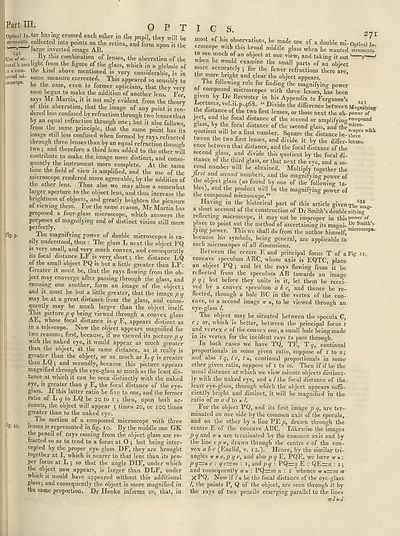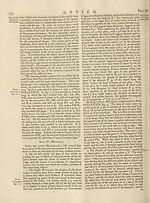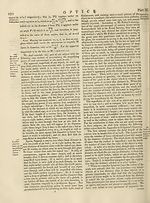Encyclopaedia Britannica > Volume 15, NIC-PAR
(291) Page 271
Download files
Complete book:
Individual page:
Thumbnail gallery: Grid view | List view

Part III.
bound mi¬
croscope.
Optical In-ter having crossed each other in the pupil, they will he
strument^ collected illto points on the retina, and form upon it the
'—”v'*"“iarge inverted image AB.
I Use of se- By this combination of lenses, the aberration of the
treral leaseshght from the figure of the glass, which in a o-lobule of
Pa c°m; the kin(1 above mentioned is very considerable, is in
some measure corrected. This appeared so sensibly to
be the case, even to former opticians, that they very
soon began to make the addition of another lens. For,
says Mr Martin, it is not only evident from the theory
of tins aberration, that the image of any point is ren¬
dered less confused by refraction through two lenses than
by an equal refraction through one j but it also follows
from the same principle, that the same point has its
image still less confused when formed by rays refracted
through three lenses than by an equal refraction through
two j and therefore a third lens added to the other will
contribute to make the image more distinct, and conse¬
quently the instrument more complete. At the same
time the field of view is amplified, and the use of the
microscope rendered more agreeable, by the addition of
the other lens. Thus also we may allow a somewhat
laigei aperture to the object lens, and thus increase the
brightness of objects, and greatly heighten the pleasure
of viewing them. For the same reason, Mr Martin has
proposed a four-glass microscope, which answers the
purposes of magnifying and of distinct vision still more
perfectly.
I he magnifying power of double microscopes is ea¬
sily understood, thus : The glass L next the object PQ
is very small, and very much convex, and consequently
its focal distance LF is very short 5 the distance LQ
of the small object PQ is but'a little greater than LF:
Greater it must be, that the rays flowing from the ob¬
ject may converge after passing through "the glass, and
crossing one another, form an image of the object;
and it must be but a little greater, that the image p q
may be at a great distance from the glass, and conse¬
quently may be much larger than the object itself.
This picture p q being viewed through a convex glass
AE, whose focal distance is q E, appears distinct as
in a telescope. Now the object appears magnified for
two reasons; first, because, if we viewed its picture p q
with the naked eye, it would appear as much greater
than the object, at the same distance, as it really is
greater than the object, or as much as L y is greater
than LQ; and secondly, because this picture appears
magnified through the eye-glass as much as the least dis¬
tance at which it can be seen distinctly w’ith the naked
eye, is greater than q E, the focal distance of the eye-
glass. ^If this latter ratio be five to one, and the former
ratio ox L <7 to LQ be 20 to 1 ; then, upon both ac¬
counts, the object will appear 5 times 20, or 100 times
greater than to the naked eye.
I he section of a compound microscope with three
lenses is represented in fig. 10. By the middle one GK
the pencil of rays coming from the object-glass are re¬
fracted so as to tend to a focus at O j but being inter¬
cepted by the proper eye-glass DF, they are brought
together at I, which is nearer to that lens than its pro¬
per locus at L j so that the angle I)IF, under which
the object now appears, is larger than DLF, under
which it would have appeared without this additional
glass j and consequently the object is more magnified in
the same proportion. Dr Hooke informs us, that, in
OPTICS.
271
1%
most of his observations, he made use of a double mi-Optical l„
croscope with this broad middle glass when jie wanted
struments.
to see much of an object at one view, and taking it out'
when he would examine the small parts of an obiect
more accurately ; for the fewer refractions there are,
the more bright and clear the object appears.
1 he following rule for finding the magnifying power
of compound microscopes with three lenses, has been
given by Dr Brewster in his Appendix to Ferguson’s
Lectures, vol. 11 p.468. “ Divide the difference between Magnifying-
.16 ^lstaHCe ol the two first lenses, or those next the ob - power of
ject, and the focal distance of the second or amplifyino*00.111?0^
glass, by the focal distance of the second glass, and them*cro' ..
quotient will be a first number. Square the distance be-tW*
tween the two first lenses, and divide it by the differ-lenses,
ence between that distance, and the focal distance of the
second glass, and divide this quotient by the focal di¬
stance of the third glass, or that next the eye, and a se¬
cond number will be obtained. Multiply together the
Jit st and seco/ul numbers, and the magnifying power of
the object glass (as found by one of the following ta¬
bles), and the product will be the magnifying power of
the compound microscope.”
Having in the historical part of this article given The ^ao.
a short account of the construction of Dr Smith’s double nifying
reflecting microscope, it may not be improper in thisPower°f
phice to point out the method of ascertaining its magni- D.r Smith,s
fymg power. This we shall do from the author himself, microscoPe*
because his symbols, being general, are applicable to
such microscopes of all dimensions.
Between the centre E and principal focus T of a Fig
concave speculum ABC, whose axis is EQTC, place
an object PQ ; and let the rays flowing from it be
reflected from the speculum AB towards an image
pq; but before they unite in it, let them be recei¬
ved by a convex speculum a b c, and thence be re¬
flected, through a hole BC in the vertex of the con¬
cave, to a second image w k, to be viewed through an
eye-glass /.
The object may be situated between the specula C,
c ; or, which is better, between the principal focus t
and vertex c of the convex one, a small hole being made
in its vertex for the incident rays to pass through.
In both cases we have TQ, TE, T q, continual
proportionals in some given ratio, suppose of 1 to n;
and also t q, t c, t x, continual proportionals in some
other given ratio, suppose of 1 to m. Then if d be the
usual distance at which we view minute objects distinct¬
ly with the naked eye, and x l the focal distance of the
least eye-glass, through which the object appears suffi¬
ciently bright and distinct, it will be magnified in the
ratio of m n d to x I.
lor the object PQ, and its first image p q, are ter¬
minated on one side by the common axis of the specula,
and on the other by a line PEyi, drawn through the
centre E of the concave ABC. Likewise the images
p q and tt x are terminated by the common axis and by
the line epn, drawn through the centre e of the con¬
vex a b c (Euclid, v. 12.). Hence, by the similar tri-
anglfis ir x e,p q e, and also g' E, PQE, w’e have tt x :
p q—x e : q e—m : 1, and 7?^ : PQrr^ E : QE=r?z : 1 y
and consequently n x : PQ=?« n : 1 whence vr x—m n~
X PQ. Now if /* be the focal distance of the eye-glass-
/, the points P, Q of the object, are seen through it by
the rays of two pencils emerging parallel to the lines
IF.I xd
bound mi¬
croscope.
Optical In-ter having crossed each other in the pupil, they will he
strument^ collected illto points on the retina, and form upon it the
'—”v'*"“iarge inverted image AB.
I Use of se- By this combination of lenses, the aberration of the
treral leaseshght from the figure of the glass, which in a o-lobule of
Pa c°m; the kin(1 above mentioned is very considerable, is in
some measure corrected. This appeared so sensibly to
be the case, even to former opticians, that they very
soon began to make the addition of another lens. For,
says Mr Martin, it is not only evident from the theory
of tins aberration, that the image of any point is ren¬
dered less confused by refraction through two lenses than
by an equal refraction through one j but it also follows
from the same principle, that the same point has its
image still less confused when formed by rays refracted
through three lenses than by an equal refraction through
two j and therefore a third lens added to the other will
contribute to make the image more distinct, and conse¬
quently the instrument more complete. At the same
time the field of view is amplified, and the use of the
microscope rendered more agreeable, by the addition of
the other lens. Thus also we may allow a somewhat
laigei aperture to the object lens, and thus increase the
brightness of objects, and greatly heighten the pleasure
of viewing them. For the same reason, Mr Martin has
proposed a four-glass microscope, which answers the
purposes of magnifying and of distinct vision still more
perfectly.
I he magnifying power of double microscopes is ea¬
sily understood, thus : The glass L next the object PQ
is very small, and very much convex, and consequently
its focal distance LF is very short 5 the distance LQ
of the small object PQ is but'a little greater than LF:
Greater it must be, that the rays flowing from the ob¬
ject may converge after passing through "the glass, and
crossing one another, form an image of the object;
and it must be but a little greater, that the image p q
may be at a great distance from the glass, and conse¬
quently may be much larger than the object itself.
This picture p q being viewed through a convex glass
AE, whose focal distance is q E, appears distinct as
in a telescope. Now the object appears magnified for
two reasons; first, because, if we viewed its picture p q
with the naked eye, it would appear as much greater
than the object, at the same distance, as it really is
greater than the object, or as much as L y is greater
than LQ; and secondly, because this picture appears
magnified through the eye-glass as much as the least dis¬
tance at which it can be seen distinctly w’ith the naked
eye, is greater than q E, the focal distance of the eye-
glass. ^If this latter ratio be five to one, and the former
ratio ox L <7 to LQ be 20 to 1 ; then, upon both ac¬
counts, the object will appear 5 times 20, or 100 times
greater than to the naked eye.
I he section of a compound microscope with three
lenses is represented in fig. 10. By the middle one GK
the pencil of rays coming from the object-glass are re¬
fracted so as to tend to a focus at O j but being inter¬
cepted by the proper eye-glass DF, they are brought
together at I, which is nearer to that lens than its pro¬
per locus at L j so that the angle I)IF, under which
the object now appears, is larger than DLF, under
which it would have appeared without this additional
glass j and consequently the object is more magnified in
the same proportion. Dr Hooke informs us, that, in
OPTICS.
271
1%
most of his observations, he made use of a double mi-Optical l„
croscope with this broad middle glass when jie wanted
struments.
to see much of an object at one view, and taking it out'
when he would examine the small parts of an obiect
more accurately ; for the fewer refractions there are,
the more bright and clear the object appears.
1 he following rule for finding the magnifying power
of compound microscopes with three lenses, has been
given by Dr Brewster in his Appendix to Ferguson’s
Lectures, vol. 11 p.468. “ Divide the difference between Magnifying-
.16 ^lstaHCe ol the two first lenses, or those next the ob - power of
ject, and the focal distance of the second or amplifyino*00.111?0^
glass, by the focal distance of the second glass, and them*cro' ..
quotient will be a first number. Square the distance be-tW*
tween the two first lenses, and divide it by the differ-lenses,
ence between that distance, and the focal distance of the
second glass, and divide this quotient by the focal di¬
stance of the third glass, or that next the eye, and a se¬
cond number will be obtained. Multiply together the
Jit st and seco/ul numbers, and the magnifying power of
the object glass (as found by one of the following ta¬
bles), and the product will be the magnifying power of
the compound microscope.”
Having in the historical part of this article given The ^ao.
a short account of the construction of Dr Smith’s double nifying
reflecting microscope, it may not be improper in thisPower°f
phice to point out the method of ascertaining its magni- D.r Smith,s
fymg power. This we shall do from the author himself, microscoPe*
because his symbols, being general, are applicable to
such microscopes of all dimensions.
Between the centre E and principal focus T of a Fig
concave speculum ABC, whose axis is EQTC, place
an object PQ ; and let the rays flowing from it be
reflected from the speculum AB towards an image
pq; but before they unite in it, let them be recei¬
ved by a convex speculum a b c, and thence be re¬
flected, through a hole BC in the vertex of the con¬
cave, to a second image w k, to be viewed through an
eye-glass /.
The object may be situated between the specula C,
c ; or, which is better, between the principal focus t
and vertex c of the convex one, a small hole being made
in its vertex for the incident rays to pass through.
In both cases we have TQ, TE, T q, continual
proportionals in some given ratio, suppose of 1 to n;
and also t q, t c, t x, continual proportionals in some
other given ratio, suppose of 1 to m. Then if d be the
usual distance at which we view minute objects distinct¬
ly with the naked eye, and x l the focal distance of the
least eye-glass, through which the object appears suffi¬
ciently bright and distinct, it will be magnified in the
ratio of m n d to x I.
lor the object PQ, and its first image p q, are ter¬
minated on one side by the common axis of the specula,
and on the other by a line PEyi, drawn through the
centre E of the concave ABC. Likewise the images
p q and tt x are terminated by the common axis and by
the line epn, drawn through the centre e of the con¬
vex a b c (Euclid, v. 12.). Hence, by the similar tri-
anglfis ir x e,p q e, and also g' E, PQE, w’e have tt x :
p q—x e : q e—m : 1, and 7?^ : PQrr^ E : QE=r?z : 1 y
and consequently n x : PQ=?« n : 1 whence vr x—m n~
X PQ. Now if /* be the focal distance of the eye-glass-
/, the points P, Q of the object, are seen through it by
the rays of two pencils emerging parallel to the lines
IF.I xd
Set display mode to:
![]() Universal Viewer |
Universal Viewer | ![]() Mirador |
Large image | Transcription
Mirador |
Large image | Transcription
Images and transcriptions on this page, including medium image downloads, may be used under the Creative Commons Attribution 4.0 International Licence unless otherwise stated. ![]()
| Encyclopaedia Britannica > Encyclopaedia Britannica > Volume 15, NIC-PAR > (291) Page 271 |
|---|
| Permanent URL | https://digital.nls.uk/192585481 |
|---|
| Attribution and copyright: |
|
|---|
| Shelfmark | EB.11 |
|---|---|
| Description | Ten editions of 'Encyclopaedia Britannica', issued from 1768-1903, in 231 volumes. Originally issued in 100 weekly parts (3 volumes) between 1768 and 1771 by publishers: Colin Macfarquhar and Andrew Bell (Edinburgh); editor: William Smellie: engraver: Andrew Bell. Expanded editions in the 19th century featured more volumes and contributions from leading experts in their fields. Managed and published in Edinburgh up to the 9th edition (25 volumes, from 1875-1889); the 10th edition (1902-1903) re-issued the 9th edition, with 11 supplementary volumes. |
|---|---|
| Additional NLS resources: |
|

